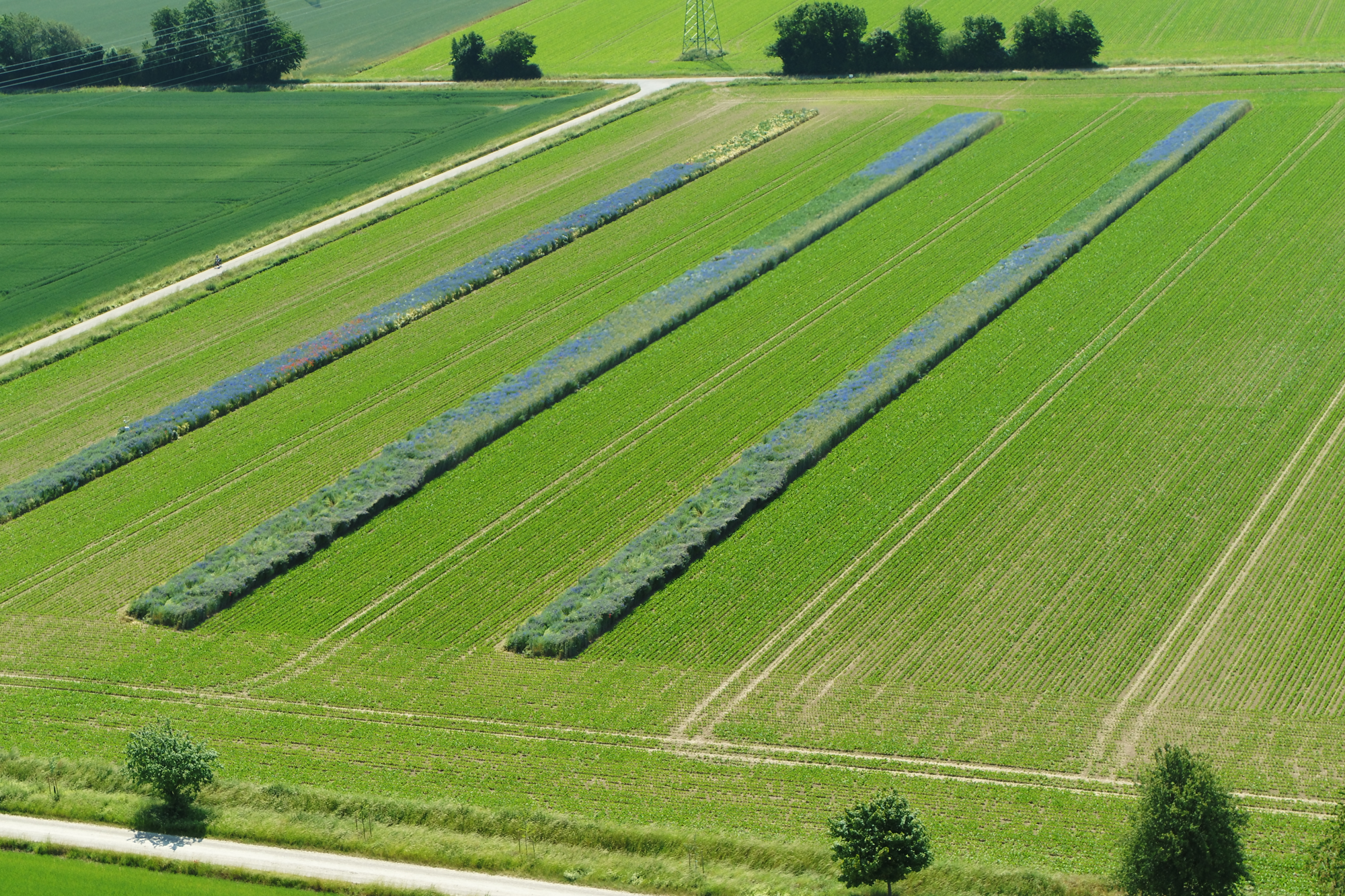
Contact

Dr. Benedict Wieters
Further Information
Project partners
Duration:
07/2021 – 06/2025
Project team:
Dr. Benedict Wieters,
Dr. Nicol Stockfisch,
Dr. Heinz-Josef Koch
Department:
Funding:
Rentenbank
Cooperations:
Leibniz-Institut zur Analyse des Biodiversitätswandels (LIB)
Landwirtschaftliches Informationszentrum Zuckerrübe (LIZ)
Rheinischer Rübenbauer-Verband (RRV)
Pflanzenschutz-Dienst der Landwirtschaftskammer NRW (LWK NRW)
Project idea: Promoting beneficial insects through flower strips
Viral yellowing can lead to heavy yield losses in sugar beet cultivation. The viruses are transmitted by aphids (especially the green peach aphid), which is why insecticides are used to secure yields.
In the FlowerBeet project, the focus is on alternative control by means of targeted promotion of beneficial insects for aphid control and on general promotion of biodiversity through overannual flower strips in sugar beet fields. The flower strips are planted in the fall before the sugar beet is cultivated. This gives the flowering plants a head start in their development at the start of vegetation in the following year, allowing them to flower more quickly than after sowing in the spring. In addition to providing food, the flower strips offer insects an undisturbed and diverse habitat at an early stage.
Trial design and parameters
Two trial approaches are being pursued in the project: three flower strips integrated into the sugar beet field with a total of five different flower mixtures or marginal strips with a basic mixture. The trials take place on farmers' fields. The areas are mainly located in the Rhineland, as the pressure from aphids and yellowing is higher there; two locations are near Göttingen.
The idea behind planting flowering strips in the middle of the field is the limited distance that beneficial insects can cover from the flowering strips to the crop. The flowering plants and varieties were selected in such a way that they are attractive to beneficial insects on the one hand and on the other hand cause as few problems as possible for the sugar beet (weed infestation, subsequent effects in the subsequent crop). The flower strips were created with a width of 6 m over a length of at least 200 m. The entire field, with the exception of the flowering strips, was treated with standard plant protection, with one exception: no insecticides were applied after sowing within one spraying width of the flowering strips. On the rest of the field, insecticides were applied according to control guidelines.
The project is investigating
the development of the flower strips
the occurrence of beneficial organisms and pests in the flower strips and the adjacent sugar beet
the effect of flower strips, beneficial organisms and pests on the development, yield and quality of the sugar beet plants
Preliminary results
Flower strip development, occurrence of aphids and beneficial insects in 2022 and 2023
Most of the sown flowering plant species emerged well and survived the winter, with few weeds appearing over the course of the year. This was partly due to the very rapid development of the cornflower, which suppressed other species. The first flowers opened in April, most of them from mid-May.
Early predation by beneficial insects can significantly counteract the establishment of aphids in sugar beet and contribute to a lower spread of the virus. In 2022, the aphids appeared in large numbers shortly after sowing, while their enemies only appeared later. This allowed the aphids to multiply quickly and form large populations. The largest number of aphids was observed between mid and late May. The heavy infestation of the sugar beet plants was easily recognizable by curled and crinkled leaves.
The results were assessed at two distances from the flower strips (3 and 10 m), in an area without flower strips and insecticide (18 m) and in the area treated as usual (38 m). In some cases, the flower strips led to a significant reduction in aphid numbers, with the effect of the flower mixtures decreasing with distance. There were differences in effectiveness between the mixtures; next to faba beans, the number of aphids in the adjacent sugar beet was often greatly reduced. However, a clear recommendation for individual mixtures cannot be derived yet. Insecticide applications have greatly decimated aphid numbers, but new infestations occurred again after the treatments. In 2023, the pressure from aphids was significantly lower after late sowing of the sugar beet due to weather conditions and was generally below the control threshold. A clearly positive effect of the flower strips could not be determined due to the low aphid numbers.
The data on beneficial insects is still being analyzed. Initial evaluations include spiders, rove beetles and ground beetles as aphid predators. Over the course of the season, aphid-feeding species groups such as lady bettles and their larvae, ground beetles, larvae of hoverflies and lacewings, web spiders and harvest spiders, as well as ichneumon wasps (parasitoids) were sighted. More beneficial insects were observed in and around the flowering strips than at a greater distance from the flowering plants.
Effects on yellowing and yield
No yellowing occurred in the areas treated with insecticide in the areas examined. In the untreated parts, there were yellowing nests and, depending on the location, 2-30 % of the area showed yellowing symptoms. In the areas adjacent to the flowering strips, the yellowed area was significantly reduced and on average 50 % smaller than without flowering strips. Interestingly, there were no increased yellowing symptoms at some locations despite high aphid numbers. It is possible that the aphids here were not loaded with viruses or that they were eaten by beneficial insects before they could transmit the virus further. In 2023, hardly any yellowing nests were observed, but yellowing viruses were detected in individual plants.
The different occurrence of aphids and yellowing symptoms in the field areas led to the expectation of yield differences. On average across all locations, there was a significantly reduced sugar yield in 2022 in areas without insecticide application (with and without flower strips) compared to the areas treated as usual (2-5 % loss). Flower strips had no positive effect on the yield and also reduced the sugar beet cultivation area. In the first row next to the flower strips, the sugar beet plants also remained so small that they could not be harvested. At three out of eight locations, there were considerable yield losses of up to 16% without insecticides. At the two locations near Göttingen, the sugar yield was 3.4 % lower without insecticides, but the flowering strips had a slightly positive effect compared to the control. In 2023, there were no yield differences between the conditions.
Depending on the location, the effects of the flower strips varied in the first year. Aphid occurrence and yield losses showed no clear correlation: some locations showed hardly any losses despite high aphid numbers, while other fields showed heavy yield losses. The role of the black bean aphid was greater than previously expected due to its massive and very early occurrence. More research is needed to predict aphid occurrence and yield losses more reliably and to develop site-adapted strategies.
Evaluation & outlook
What could this mean in practice?
Despite the high level of beneficial insect activity and the reduction in aphid numbers in the vicinity of flower strips, the expected positive effect was not seen in the areas with flower strips. For the overall evaluation of the new cultivation system, the loss of arable land due to the flower strips and possible after-effects of flower strips on the following crops must also be taken into account. No serious problems have been identified so far, but flowering plants are often also found in the subsequent crop.
Even if the system does not pay off in its current form, the findings are valuable. The cultivation method can be combined with other measures as part of integrated plant protection and further optimised to reduce costs and effort. As a flexible protective measure against aphids and other pests, the promotion of beneficial insects is a fundamentally sensible measure, as they can regulate pest populations independently of the availability of effective insecticides. A general promotion of the biodiversity of plants, insects and other animals on arable land can thus contribute to the robustness of the cultivation system against disturbances.
Funding
The project is being carried out by the Institute for Sugar Beet Research (IfZ) in Göttingen in cooperation with the Leibniz Institute for the Analysis of Biodiversity Change (LIB) in Bonn. The Rheinische Rübenbauer-Verband (RRV), the Landwirtschaftliche Informationsdienst Zuckerrübe (LIZ) and the Landwirtschaftskammer NRW are also involved. The project is funded by the Landwirtschaftliche Rentenbank.
Funding

Contact









